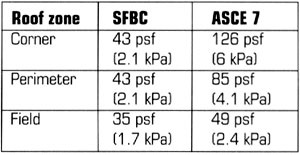Professional Roofing welcomes letters to the editor. Views expressed in "Letters" are not necessarily those of NRCA. Letters must be signed and include a return address and telephone number. Professional Roofing reserves the right to edit letters for clarity and length. Send letters to Ambika Puniani, Editor, Professional Roofing, 10255 W. Higgins Road, Suite 600, Rosemont, IL 60018-5607; fax (847) 299-1183; or e-mail apuniani@nrca.net.
Reader comments about SFBC
I take exception to Thomas L. Smith's, president of TLSmith Consulting Inc., Rockton, Ill., comments in "Hurricane Andrew—10 years later," August issue, page 34. Smith states Hurricane Andrew proved "SFBC's [South Florida Building Code's] wind-load requirements for building envelopes were grossly inadequate." Having been involved in the design and construction of commercial and organizational buildings throughout Florida from 1956-96, particularly from the Florida Keys to Palm Beach, my company designed [buildings] according to the Miami and Dade County codes before the adoption of SFBC. To my knowledge, we did not lose one building. [Hurricane Andrew's] disaster was a result of failure in design and construction.
In 1958, we completed a cottage on the Atlantic waterfront of Plantation Key. When Hurricane Donna hit, the only damage was some scarred furniture. Clothing in the closets was not even mussed. The owners were ecstatic. Similar construction in the Keys was totaled.
Six weeks before Hurricane Andrew, we completed an addition to a residence in south Dade County, which included a new tile roof system. The location was in the northeast quadrant … on the Hurricane Center Chart. We did not lose one tile. There were broken tiles from flying debris, but no penetration of the roof or building occurred. Construction was monitored carefully throughout the entire building process.
Our success has been a result of careful attention to details, the best engineers in the profession, [careful] selection of contractors, and diligent and unrelenting construction observation. SFBC was a good code that only needed fine-tuning, but Hurricane Andrew opened the floodgates of confusion and opportunism. In reflection, I wonder whether those who have tried to ensure that buildings must be indestructible have not created a different catastrophe.
Harold Seckinger
Harold Seckinger Architect
Homosassa Springs, Fla.
Following is Smith's response to the letter:
"I agree that careful attention to details, employment of competent designers and contractors, and diligent observation during construction are key to achieving good wind performance. However, my statement in the article that ‘in the scrutiny that followed the storm, it was discovered SFBC's wind-load requirements for building envelopes were grossly inadequate' is true.
"I calculated design loads on a roof system on a 20-foot- (6-m-) high enclosed building in a suburban area south of Miami (Exposure B) using the 1988 editions of SFBC and ASCE 7. I used the basic wind speed given in the referenced document (SFBC specified a higher speed than ASCE 7—the SFBC speed was used for the SFBC calculations, and the ASCE 7 speed was used for the ASCE 7 calculations). Results are shown in the figure.

Design loads of a 20-foot- (6-m-) high building calculated according to the 1988 editions of SFBC and ASCE 7.
"SFBC's corner load is low by a factor of three, and the perimeter load is low by a factor of two. SFBC's field load also is lower than the field load derived from ASCE 7.
"Although many changes made to SFBC after Hurricane Andrew may be controversial, the decision to use ASCE 7 for wind-load determination was prudent."
